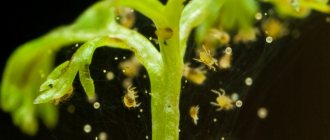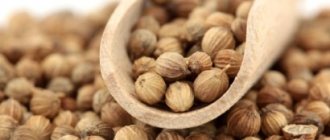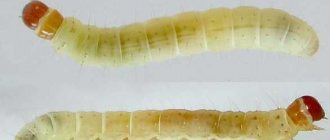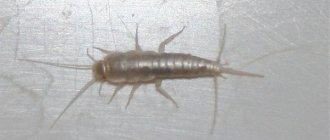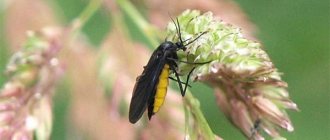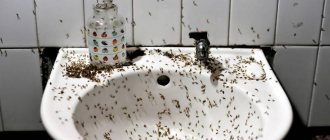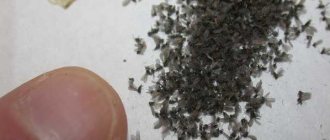Every gardener at least once in his life has encountered such a problem as midges in indoor flowers. Black midges with wings, white ground fleas or white-winged midges regularly bother you, which means this article is just for you.
In this article we will tell you why midges appear in indoor plants, what methods exist to combat them and methods of prevention. You will also learn about effective folk remedies that will help you get rid of unwanted insects.
What are these white worms in an indoor flower?
- Fly larvae;
- Nematodes;
- Enhythrea;
- Fungus gnat larvae (sciarids);
Parasites settle on a houseplant if the plant is weakened or the indoor microclimate is conducive to reproduction. They are usually localized on the lower leaves, in the upper soil layer of the pot, and on the roots of the flower. Both adult plants and larvae feed on the juices of the indoor flower, and the latter begins to get sick, withers and dies.
Fly larvae, sciarids up to 4 mm in length, white. Adult hatchlings have wings. They reproduce equally in moist and dry soil - they are more attracted to the environment in the room where they are comfortable.
Enchytraea are white worms up to 2 mm. They are similar to earthworms, as they are the closest relatives to them. If you are not a fan of fish in the aquarium that are fed with enchytraea, remove the parasites, otherwise they will multiply, each time capturing a deeper layer of the soil mixture. They appear in waterlogged soil and love rotted organic matter.
How to remove white worms from an indoor flower?
Since most of the midges and worms are in indoor flowers, we will dry the soil mixture to kill the pests.
How to remove white worms from an indoor flower:
- Stop watering the plant;
- Fill in expanded clay, dry hydrogel, beads - it prevents stagnation of water and prevents the laying of larvae;
- To catch and poison midges - spread sticky tape over the pot and spray the midges with dichlorvos (attention: ventilate the room before sleeping);
- Mix wood ash + tobacco shavings into the soil;
- Clean the sulfur from the match head;
The listed methods will help kill white worms in indoor flowers, but if there are too many of them, you will have to use chemicals.
How to treat flowers against white worms:
After several stages of treatment and elimination of white worms, replant the houseplant into a healthy, fresh soil mixture. Treat the substrate and prevent the reappearance of parasites. During the replanting process, you may notice larvae or worms on the root system - remove them, trim off the damaged areas and treat the roots.
Soil treatment against white worms in flowers
The soil mixture is steamed or spilled with a solution of potassium permanganate before use. Try not to over-moisten the soil in the pot, lower the humidity and air temperature to a level comfortable for indoor flowers. Carry out insecticide prevention once a year.
↓ Write in the comments how you managed to cope with the invasion of white worms in indoor flowers? What methods did you use? Were you able to completely get rid of the parasites?
Please rate the material you read :)
Partial or complete replacement of soil
To radically get rid of both midges and their larvae at once, you can replace the soil. If it has not turned sour and the roots have not rotted, it will be enough to remove 3-4 cm of the top layer (for small flowers - 2 cm). A sterile substrate, well calcined and/or spilled with manganese solution, is prepared as a replacement. It is recommended to mix wood ash into it. The bottom layer is filled with an insulating layer of clean calcined river sand or fine drainage, and then with a prepared earth mixture. Instead of calcination (or in addition to it), you can use the method of freezing in the freezer for several days.
If the sciarids have reproduced in full force, partial replacement may not be effective. In this case, the land is completely changed.
If there are pieces of rotting roots left in the soil, it is unsuitable for use!
Types of insect pests similar to worms
White or transparent worms in indoor pots are a warning sign. Pests weaken the plant and slow down its growth. The flower stops producing buds, the leaves turn yellow and wither. These worms can be either adult insects or their larvae. Whatever they are, if timely measures are not taken, the plant may die.
Insect larvae
When we talk about larvae, we usually mean several genera of insects from the order Diptera.
Mushek
Springtails (springtails, springtails) are tiny arthropods no larger than 5 mm in size. They have a jumping fork in the lower part of their body, which allows them to move quickly. Some specimens are so small that they are difficult to see. Often, owners notice white worms in the tray, in the water remaining after watering. Insects live in the soil and feed on organic debris. If this nutrition is not enough for them, the roots of the flower and young shoots are destroyed. Waterlogged soil is a favorable habitat.
Fungus gnat
Representatives of the Sciarich family that indoor gardeners encounter:
- sciara midges;
- fungus gnats;
- genus Bradysia.
Only a specialist can find the differences between these insects, but the damage they cause and the methods of control are almost the same. The insect is a small mosquito. The length of the thin body is 3-4 mm, the head is round. It has only a front pair of transparent wings, and in place of the hind wings there are club-shaped halteres.
Insects fly well and reproduce quickly. A young mosquito has a light gray body, which turns black with age. Adults do not cause any particular harm to plants, but can carry various diseases and the larvae of other pests.
The main damage is caused by fungus gnat larvae - white, transparent worms 3-5 mm long with a black head.
Insects damage the root system of indoor flowers. The supply of nutrients and moisture to the plant is disrupted, and the flower may die. The larvae get in with the contaminated soil. The second way for adults to enter an apartment is from the street through open windows. Mosquitoes prefer waterlogged soil.
Nematodes
Nematodes (roundworms) are protostomes. Zoologists suggest the existence of about a million species on earth. They live in fresh and salt water bodies, in the soil.
Nematodes are tiny worms in indoor flowers that grow in moist soil and feed on living and dead plants.
Types of plant nematodes:
- Galls that settle on the roots, their secretions contribute to the formation of thickenings in which pests live and reproduce. When the eggs mature, the shell is destroyed and the larvae spread in the soil.
- Nematodes with free formation of cysts are attached to the root.
- Free nematodes do not have a permanent place of residence, crawling and damaging various plant organs.
Signs of nematode damage:
- the appearance of yellow and subsequently brown and black spots on the foliage;
- reduction in leaf size, their deformation;
- curvature of stems, drying of apical buds;
- the formation of thickenings and swellings on the root system.
Choosing the right neighbors for roses in the country
Plants that attract aphids.
Some wild trees and shrubs intensely attract pests, so it is not recommended to plant them either in the garden plot or next to it.
Plants that attract aphids:
- viburnum;
- Linden;
- bird cherry;
- mulberry;
What's bad about the company? Wild trees wake up earlier, throwing out their tender green shoots and flowers, and hungry insects flock to them from all over the area, beginning their life cycle. At the moment when your roses wake up, the pest has already created a large population and is moving into your flower garden and vegetable garden. And in this situation it is difficult to fight only with folk remedies.
In addition, there are popular flowers that also attract pests. Of course, compared to shrubs and trees, they do this on a much smaller scale.
Flowers that attract aphids:
- Petunia
- Nasturtium
- Begonia
- Cosmea
- Poppy
- Mallow
Plant allies against aphids
Let's look for helpers in our struggle among the plants. You can plant fragrant herbs and flowers in the area next to the roses that the pest does not like.
Plants that repel aphids:
- mint, lavender, sage, thyme, dill, parsley and fennel
- marigolds and daisies.
Plants that distract aphids:
clover, lupine or rapeseed.
How to kill aphids? Beneficial insects
Unlike ants, which spread pest larvae throughout the garden, ladybugs help fight it. One such insect destroys about 700 aphids in natural conditions. We attract the ladybug to the area with tansy, dill or chamomile.
We install poultry houses for sparrows, tits, kinglets, etc. The birds feed on these larvae and also feed their chicks with them.
Toads will save roses from aphids and ants
Having toads in the garden is a wonderful method: aphids and ants will simply disappear. Toads love these insects and will hunt them. While there are toads in the garden, you can simply forget about pest control.
Varying control methods keep insects from becoming resistant to a particular toxin. Alternate all the methods you know to control rose pests. If one method is used predominantly, the surviving individuals pass on their qualities to the new generation, creating a more stable population.
Typically, after the first aphid infestation in May/June has been successfully repelled, natural predators such as ladybugs, wasps and toads help keep insect numbers in the garden under control.
Even the best folk remedies can lead to dehydration of the surface of rose leaves (they wash off the moisture-retaining wax coating from it, just like with aphids) and can harm beneficial inhabitants of the garden, for example, bees. Therefore, treat only those areas where there are aphids, and sometimes it is more effective to simply wash off the larvae with a sponge and soap than to mindlessly spray the entire rose bush.
What to do if there are white worms in an indoor flower? :
One day, not yet knowing what to do with them - there were small white, motionless, apparently larvae and nimble little adults - I pulled the flower out of the ground, transplanted it into another, and simply took this one with the worms outside into the cold and specially checked it later. There was no one there anymore, and I used this soil later or not, I don’t remember. Now it’s the same story with another flower, but I just replanted it, so what, should I replant it again?
Three times in the winter I replanted the balsam (wet vanya) and washed it in manganese and still it appeared again, although the ground was frozen.
They say that soaking doesn’t help, you just need heat treatment, steam or something else.
I baked all the soil in the oven, and it didn’t do anything. Mom suggested a recipe for iodine + milk + water, maybe it will help.
Fighting methods
If there are pests in a flower pot, you need to get rid of them urgently. Depending on the degree of damage, choose control methods.
Mechanical
Since white worms live mainly in the soil, mechanical removal is ineffective. You can remove or wash off the adult specimens from the roots, but you will not be able to get rid of the eggs and larvae. If pests have just appeared, replant the indoor plant in healthy, calcined soil. Treat the soil with insecticides. When replanting, remove adult insects, larvae and eggs from the root system. Trim damaged areas and treat with disinfectant solutions.
Chemical
In a specialized store you will be offered several proven drugs for controlling soil pests:
- "Carbation" is a fumigatory agent. Used once to protect the flower and to sterilize the soil.
- “Agravertin” is a safe, highly effective product that does not cause addiction among pests, and its effectiveness increases in the hot season.
- “Fitoverm” – a few hours after treatment causes paralysis in pests, after 2-3 days they die. Apply by spraying, re-treatment is recommended.
- “Confidor” - the active substance penetrates the plant tissue, the effect lasts for a long time. The drug can only harm insects.
- "Intavir" is a nerve poison that affects most insect pests. Within half an hour the feeding process stops, and within 24 hours the pests die. Does not destroy eggs.
Chemicals are toxic; safety rules must be strictly followed.
Folk remedies
If you are not a supporter of chemical reagents, try folk remedies:
- Prepare a pale pink solution of potassium permanganate and water the indoor plant several times with this solution.
- Use a soap solution for spraying.
- Place citrus peels, garlic cloves near the flowers, and treat the soil with anise oil.
- Prepare a solution of 5 g of tobacco dust and a liter of water. After steeping for 24 hours, spray the plant and soil in the pot. Repeat the procedure once a week for 1-1.5 months.
How to get rid of fruit and flower midges (drosophila and sciarid flies)
Midges in flowers are not only small flying flies, but also their larvae that live in the ground. Several generations of insects can simultaneously develop in one pot, from eggs to adults. Also, keep in mind that fungus gnats can spread quite quickly from one plant to another. Therefore, in order to remove insects forever, you need to fight them comprehensively and often repeatedly.
Fighting methods
Instructions 1. Using folk remedies
Step 1. Let the soil dry out after the last watering so that at least 2 cm of the top layer is dry.
Step 2: Catch all adults. You can do this using:
- Traps: special (for example, a regular fly catching tape will do) or homemade. Here are two ways to get rid of midges in flowers using homemade traps:
- Fill a small jar with something sweet and aromatic (e.g., red wine, apple cider vinegar, fruit juice), or add a piece of overripe fruit (e.g., banana) or some honey.
- Close the jar tightly with a tin lid and make tiny holes in it using a nail and a hammer. You can also make a funnel out of a piece of paper or cover the trap with cling film with small holes (see photo below). The idea is that the midges will come to the smell, but will not be able to find a way out of the jar. Therefore the holes must be really small.
- Place the jar next to the indoor flower and wait a couple of days. You will see that all the midges are stuck in the trap.
- Make flags out of toothpicks and paper, much like the picture below.
- Coat the flags with honey.
- Insert the resulting flags into all flower pots where fruit flies have appeared.
- If necessary, the flags can be changed every day or every other day.
Homemade trap for flower midges
- Vacuum Cleaner: To get rid of midges in flowers using a vacuum cleaner, remove the brush attachment and simply “vacuum” the ground and area around the plant. The vacuum cleaner will easily capture insects even in flight. The midges will get into the bag/dust collector, get stuck there and, most likely, will not be able to fly out of there. But it is advisable to immediately after the procedure empty the vacuum cleaner outside the apartment (or throw away the disposable bag) and treat it with dichlorvos.
Step 3. So, we got rid of the adult egg-laying midges, now we need to cultivate the ground to get rid of the larvae. To do this, loosen the dry soil and water the plant with one of the following folk remedies:
- Garlic infusion: make a garlic infusion at the rate of: 1 grated head of garlic + 600 ml of boiling water per 1 flower pot. Let the product sit for 2-4 hours, then water and spray the plant with it, and deepen the remaining pulp into the ground. You can also stick 1 head, cut into three pieces, into the soil of each infected plant. Don't worry, the smell of garlic will not appear in the apartment.
Garlic as a natural insecticide for flower gnats
- Potassium permanganate solution: it should be so weak that it appears colorless in the palm of your hand. Water and spray the plant with the solution no more than once a week for a month.
- Soap solution: grate 20 g of laundry soap and dissolve it in a liter of warm water, then water and spray the plant with the resulting solution.
- Sulfur: Stick 4 matches into the ground, heads down, at equal intervals, and lightly water the plant. Change matches every other day for a week.
- Antiparasitic solution for pets: Buy anthelmintic medications, such as Drontal, from a pet store. Dilute the product in a dosage suitable for cats or puppies in water and water the plant as usual. It is advisable to repeat the procedure after a week.
Instruction 2. Using insecticides and creating a “toxic greenhouse”
This method is effective, economical and, if done correctly, safe for humans and plants. With its help you can kill both larvae and adults.
Step 1. Wait until the soil becomes dry after the last watering.
Step 2: Gently loosen the soil.
Step 3. Place the pot with the plant in an ordinary bag, spray a little Dichlorvos into the soil and tie the bag tightly so that only the pot is completely covered. After 4-5 hours, the midges in the ground should die.
- If midges have appeared not only in the ground, but also settled under or above the leaves, then you need to do all the same steps, but choose a bag of such a size that the entire plant can fit in it “in full growth”, and spray Dichlorvos not only in soil, but also on the package (!). In order not to damage the plant, it is important that the product does not get on the leaves, and to prevent them from becoming crushed, you should secure the bag with tape at the desired height to the furniture, door or floor lamp. Another way to create a “greenhouse” is shown in the picture on the right. The product will destroy insects both in the ground and on leaves in 7-10 hours.
- Dichlorvos can replace Raptor, Neo or Raid. In addition, instead of sprays, you can use solutions of special insecticides for plants, for example, Groma-2, Aktary, Bazudin, Actellik and Karbofos. In this case, before wrapping the plant in polyethylene, it must be watered and sprayed with the product.
Step 4. Hang special or homemade traps on the windowsill so that the remaining midges that did not fall under the bag will land on them.
Step 5. Repeat the procedure after 8 days to eliminate the possibility of midges reappearing.
If there are a lot of larvae in the soil, and you are sure that the plant will withstand replanting, then it is best to do this by transplanting the flower into new, pre-treated soil. To do this: loosen the soil and carefully pull it out, then clean the roots from the contaminated soil by hand or using a small brush, then quickly rinse the roots with water or one of the home remedies listed above and finally, replant the plant in a clean pot with uninfected soil. To prepare the soil, you need to bake it in the oven at a temperature of 100-120 degrees for 1 hour, and then restore the microflora with some kind of fertilizer.
Directory of indoor plants
Main menu
Dried leaves, weakened stems, diseased rhizomes of the plant, pale and fading buds - all this is the result of damage to the crop by parasites that consume all its juices and nutrients. Caterpillars, spider mites, earwigs, thrips, small white worms in the soil of indoor plants - this is not the whole list of harmful insects that actively attack and infect the plant.
Experienced flower growers advise starting the fight against dangerous guests with proven and effective means.
Flower growers know how to eliminate some parasites that feed on various parts of the home flower. The success of such an operation will depend on understanding what type of parasite attacked the flowerpot.
Pests come in a variety of sizes and shapes, but many insects and arthropods prefer young, nutrient-rich plants. They lay eggs on leaves and in the earthen mixture. Some parasites are clearly visible on domestic flowers, others hide in the lower part of the leaf, accumulate in the area where the leaf attaches to the stem, or hide under the top layer of soil.
Mealybug
Such a small insect is very difficult to recognize with the naked eye; for this you will need to use a magnifying glass of at least 6 millimeters. Characteristic features:
- A white waxy coating, which looks more like powder, protects the pest from insecticides. Mealybug can be eliminated only through careful and regular treatment of the affected plant. The main sign of the disease is that white insects have appeared in the soil of indoor plants.
- Insects love to settle in the axils of the leaves; they entwine the leaves with a thin white cobweb.
- The optimal condition for a plant to be affected by a mealybug is high air humidity and a temperature above 25 degrees Celsius.
- Parasites are accustomed to accumulating in groups; from the outside it may seem that the crop is covered with dirty white cotton wool.
- Many parasites spread on leaves and stems, sucking out the nutritious juice from the plant. Some types of parasites live on the roots, depriving the crop of all nutrients.
- It is not for nothing that flower growers classify mealybugs as a dangerous parasite: an infected crop very often dies in a short time and turns out to be unviable.
- tincture with orange or lemon zest;
- soap-alcohol solution;
- garlic tincture;
- treating the plant with running water;
- a mixture of olive oil and liquid;
- tincture of horsetail.
We invite you to familiarize yourself with Ginger plant species
Spider mite
The spider mite is at least 1 millimeter in size, but despite its size, it does a lot of harm: larvae and adult parasites actively suck the juice from the crop, causing leaves to fall off, turn yellow and lose chlorophyll pigments.
Over time, the discolored leaves begin to dry out, curl, and fall off. Throughout time, the flower becomes weaker and weaker. The places where small ticks are located are covered with a thin layer of cobwebs. Adult mites are red-brown or green in color and are very difficult to find among the leaves and stems of the plant.
Female web spiders are very fertile and can lay hundreds of new eggs every three days. Without regular inspection, thousands of small mites quickly drink all the plant juices, and the indoor flower begins to quickly die.
How to eliminate the parasite:
- The main thing in this case is to identify problems with the plant in time. At an early stage, while there are not so many pests, it is easy to get rid of them, but if the parasite begins to actively multiply and reaches a large number, then the death of the flower can almost not be avoided.
- Treatment of plants with biological preparations is effective when the crop is weakly infested. More popular products: Agrovertin, Vermitex, Kleschevit.
- If there is a large number of pests, you will have to use insecticidal and acaricidal preparations: Floromite, Sunmite and Oberon.
- Ticks react poorly to hot water: to eliminate adult parasites and their larvae, you need to wipe the leaves with a special sponge soaked in a heated liquid.
Thrips lesions
Thrips are small flying insects with an elongated body, their color combines a dark brown-black tint, with reddish speckles above and yellowish below.
Insects lay their eggs mainly on leaves and stems, and do not descend to the ground. Recognizing thrips on a plant is quite simple: the leaves turn grayish-brown at the bottom, with a predominant silver color on top.
On the lower part of the leaves there are entire colonies of small pests. The parasites continue to drink the juice, depriving the indoor plant of nutrients. Over time, the leaves begin to quickly lose their green color, dry out, the buds become covered with small spots and change their shape.
The danger of the parasite lies not only in the lack of nutrition for the affected plant. The pest begins to excrete liquid excrement, which creates a favorable environment for the formation of an extremely dangerous disease - sooty fungus.
In the process of active reproduction of harmful insects, indoor crops begin to weaken and lose all their decorative qualities.
What you need to fight thrips:
- good watering: thrips simply cannot tolerate moisture;
- regular inspection, mechanical elimination of thrips;
- treatment of the crop with fungicides and systemic insecticides that penetrate into the root system itself, into the leaves and stems of the indoor crop.
rose aphid
Rose green aphids reproduce very quickly. The female of this species lays more than a hundred eggs, and she can lay clutches every ten days. Agree, these are simply unimaginable rates of reproduction. The pest lives in all climatic zones. He must be poisoned mercilessly!
The larvae grow quickly, and under their influence the growth of stems stops. The shape of the flowers becomes ugly. Their aroma is lost. The leaves first curl into tubes, then turn yellow and fall off. The straightness of the stems is lost under the influence of aphid larvae. New buds do not appear at all.
Most often, aphids appear together with black ants. Or rather, they bring the larvae to the rose bushes. Black ants are not just the eternal companions of aphids, but their shepherds. They eat the sweet-tasting waste products of the larvae. Amazingly, black ants carry the larvae into their warm anthills for the winter, and in the spring they deliver them to plants, including roses. If you notice black ants in your area, then there are aphids there too.
The rose green aphid is a dangerous pest. Proceed with its destruction immediately after discovery. Better yet, take proactive action.
Here's how you can treat roses against pests, following the advice of flower growers.
The first time is in early spring, when the buds on the roses have not yet begun to swell and the aphid larvae are already crawling out of the soil, spray the bushes with insecticides. Or rather, an aqueous solution of one of these drugs. In the future, treatment of roses against pests is repeated every 10 days. Don’t let the frequency of spraying scare you, because we are not talking about a fruit plant, but about flowers.
Aphids are a very tenacious pest that can adapt to the effects of insecticide. Therefore, the means need to be alternated. For the first time, spray the flowers with contact agents such as Iskra or Commander. For the second treatment, drugs with a similar effect - Actellik and others - are perfect.
All of the above drugs kill larvae and adult insects. Of course, they cause some harm to the roses themselves, but it is minimal compared to the damage from aphids. It is not possible to destroy aphids using folk methods, but it is quite possible to expel them from the bushes.
For example, a very weak aqueous solution of kerosene successfully copes with this task. To prepare 10 liters of solution, only 2 ml of kerosene is required.
There are more complex folk recipes. So, if you take 300 g of peeled garlic cloves, chop them, mix with 400 grams of chopped tomato leaves and infuse this mass in a three-liter jar of water, you will get a very effective infusion.
The time for infusing this product should be at least 6 hours. Keep the jar in a warm place. Then mix the contents of the jar thoroughly, strain, and squeeze out. Add clean water to the resulting extract so that the total volume of the substance is 10 liters, dissolve 40 g of black laundry soap in it. It is necessary for better adhesion of the infusion to the leaves and branches.
Spray the bushes with this product every week. It has a good repellent property not only for aphids, but even ticks.
Prevention measures
It is easier to prevent insects from infecting plants than to fight them.
Listen to the advice of experts:
- Even if you notice one fly or worm, check all the pots.
- Replace the soil, wash the containers.
- Adjust watering, do not over-moisten the soil.
- Do not use folk remedies for fertilizer - tea leaves, meat juice. These products create favorable conditions for the proliferation of pests.
- Do not place vases with purchased flowers near indoor plants.
Monitor newly acquired plants and soil. Follow the rules of flower care; a healthy plant is less susceptible to pests.
Rules for treating with insecticides
It is not enough to treat only the plant and the container in which it grows. It is necessary to carefully treat the window sill or shelf and the nearby walls (especially the cracks in them). If there are other crops nearby, for preventive purposes you need to spray the product on them as well. The bottom of the pot and its tray are especially carefully processed.
Vegetable garden and more
This section covers occasional houseplant pests. They may appear if the plant is taken out into the garden or onto an open veranda. When moving a plant from the street, you need to inspect it, since pests such as slugs, weevils, caterpillars and others can be detected, if any, by looking under the leaves. If the plant was brought into the house and after some time the plant began to lag in growth, wither, or eaten areas of stems, leaves and flowers began to appear, then it is worth checking it for the presence of pests. Moreover, if there is no pest on the above-ground parts of the plant, then it is possible that it is hiding in the roots. Therefore, you need to remove the plant from the pot and inspect the roots.
How to prevent aphids?
To prevent the appearance of green midges on roses, you must adhere to the following recommendations:
Pests can be found on the inside of leaves
- Before planting new plants in the ground, carefully inspect them for the presence of aphids. It can also be on roses that are decorated in bouquets;
- buy strong plants that have strong leaves, roots and stems;
- Plant umbrella crops near decorative flowers. These include carrots, parsley, fennel, dill and others;
- In the garden where roses grow, evenly place several flower pots with wood shavings throughout the area. It will attract earwigs, which feed on these pests;
Place as many birdhouses in your garden as possible
No chemical attacks
Having discovered small populations of insects, you can do without the use of chemical reagents.
- When a springtail is first detected, completely immerse the entire flower along with the pot in water. The floating insects are immediately collected. The plant should not be watered. The top layer of soil (up to 40 mm thick) is removed, and clean, dry sand is poured in its place.
- If podura pests are found in a flowerpot with orchids, the plant is removed from the bark and the roots are washed well with water. The processed rhizome is planted in the whole bark. The rot is cut off and the sections are dried.
Caterpillars
These are mainly garden pests, sometimes they fall on indoor plants if the flowers are placed in the garden for the summer. The caterpillars come from trees or bushes under the window. A sure sign of their appearance is eaten holes on the leaves. In the photo, the leaf roller caterpillar, in addition to nibbling the edges of the leaves, weaving a web and molding branches and leaves, will subsequently weave a cocoon from the web, where the caterpillar will begin to turn into a butterfly.
The earwig hides under leaves during the day, in the ovaries of flowers, and at night it comes out and eats leaves and young shoots, so carefully inspect all the secluded places on the flowers and pick off insects.
Control measures. Manually remove pests from plants. As a preventive measure, you can spray with insecticides, but if the plant is standing in the open air, the chemicals are quickly washed off. Caterpillars eat the leaves of plants, but getting rid of them is not difficult, just wipe the leaves with a sponge and remove all the cobwebs and insects.
Intavir helps against leaf eaters. Unfortunately, pesticides only affect young caterpillars.
Mechanical method
If aphids have appeared on roses, then how to get rid of them is a task that even experienced gardeners often face. In fact, there are plenty of methods to combat aphids on roses. It all depends on the degree of infestation of the bush and how quickly you were able to identify the impending threat. You can destroy aphids on domestic roses without much difficulty if there are not many insects yet. You don't even have to spray the roses to do this. In this case, it is better to resort to mechanical methods of eliminating aphids.
How to deal with aphids and what methods are best to use:
manual collection. The insects that appear can simply be collected with your own hands. The process is not particularly difficult, but in order to get the desired effect, you must adhere to certain rules. For example, carefully inspect the bush. Aphids love to hide not only on the rose, but also under its leaves. Having missed at least a couple of pests, you will soon be forced to deal with their entire population. After you have freed the plant from parasites, it is recommended to destroy them. Otherwise, they will crawl around the garden again and find their prey; washing. Aphids on roses are a serious problem that needs to be combated with proven means. If during the process of manually collecting pests you may have missed several individuals, water will help wash away the insects from the bush. Do not rush to treat shrubs with chemicals. Water is a good remedy for aphids that appear on roses.
But be careful: you should water the plant carefully; if the flow of water is too strong, you can simply break the branches of the bush; If aphids appear in your garden, your helpers will be able to remove them. Birds (sparrows or titmice), ladybugs, and hoverflies cope well with these insects
Provide water and food for them in your garden and you will get rid of aphids in no time.
The fight against aphids on roses will be effective if you approach the destruction of pests correctly. By resorting to mechanical methods, you will not only save money, but also remove insects that have gathered on roses in small numbers. If things are much more serious, it's time to consider some radical methods.
Whitefly
This is an insect with a body length of no more than 2 mm. A characteristic feature is white wings and a yellowish body. They can be found:
- On the back side of the leaves, where they are located in colonies.
- According to characteristic sweetish traces, on which after some time a sooty fungus appears.
Whitefly larvae have a sucking type of mouthparts, so they suck out the juices from the plant. As a result, the plant loses its vitality and gradually loses its attractiveness. If no measures are taken, the plant will soon die.
Interesting fact! When appearing in greenhouses, the whitefly prefers plants such as hibiscus, pelargonium or begonia. After the appearance of just one individual, after a short period of time a whole colony of these insatiable pests appears in the greenhouse. In this regard, the fight should begin immediately.
These are also harmful insects that suck juices from plants due to the presence of piercing-sucking mouthparts. Insects have an ovoid body shape, no more than 2 mm in length. Aphids have rather long legs, but they move rather slowly. The color of insects depends on the species, as well as on living conditions, so it can be varied.
Green aphids on roses: how to treat them and what to do if insects appear
It is difficult to find a person who would not love roses - the queen of flowers. But its cultivation often involves a lot of hassle and worries, and the fight against malicious flower pests. Green aphids are considered one of the most common; they are able to settle in colonies on developing buds, devastate them and they will never be able to bring joy to the grower - the flower dies without ever opening.
Small green insects appear on roses at the end of May, beginning of June, when the plant is gaining buds, and during the summer season the female is able to breed more than one offspring, and if the fight against the harmful insect is not started in time, the entire rose garden may die.
She can migrate along with ants from various plants devastated by her and onto roses, because her buds have not only a unique aroma that attracts pests, but also sweet juice, which she feeds on. Amateur gardeners have long noticed that the most active period of aphid attacks is observed during the formation of shoots on garlic and the appearance of stepsons on tomatoes - science does not explain what this is connected with.
At first, only a few insects appear on the rose bush, which an inattentive gardener may not notice, and this can subsequently lead to reproduction, and a whole colony will parasitize the bush. You can read what kind of preparation you can use to treat a rose against aphids for the best result in this article.
They will harm not only the developing flower stalks, preventing them from developing and blooming properly, but also the leaves, without which the plant withers - after all, the rose receives all its nutrition through the leaves. Young shoots, as the softest and sweetest ones, attract aphids; the bush will not be able to continue to grow new branches, it will ultimately become weakened and unviable, and if the colony is too large, it will die altogether. It will also be useful and interesting to learn about how to treat peonies against ants.
In the video - the harm of aphids to roses:
Signs
Most often, the parasite settles on young shoots of rose bushes, the tops of the plant, where the bark is more pliable and easier to bite through. It can be detected even without a magnifying glass; the entire branch is covered with insects, and you can find:
- Incorrectly developing new shoots and flower stalks;
- The leaves curl up or take on an irregular shape, most often this happens on young green shoots;
In a very short time, the plant is covered with a coating with characteristic glossy and nectar characteristics, that is, in another way, honeydew, which garden ants, carriers of aphids, are very fond of. The resulting coating interferes with proper oxygen exchange, so the plant becomes weakened, the branches are thin and unsuitable for the formation of luxurious peduncles;
Gradually, the entire bush will simply be covered with a colony of aphids, leaves and buds may no longer be present, but the ants continue to collect the nectar secreted by the aphids; As a result of the vital activity of parasites, all the foliage becomes thin, weak, the natural bright green color is lost, and they gradually fall off, which ultimately leads to the death of the rose bush; The development of buds stops, the flower stalk weakens, nutrients can no longer flow through it, which leads to their falling off.
It will also be interesting to learn how effective the fight against aphids on roses is with ammonia, you can see in this video.
An attentive florist involved in growing a rose garden first of all examines the rose bushes for the presence of a pest, and at the first signs of damage, he begins to actively act so that the bush does not die and beautiful roses appear on it.
Another pest in the garden is moss, but you can read here how to properly combat moss in your garden plot, and which means are the most effective.
Centipedes
These whitish or dark brown insects, similar to a caterpillar with numerous legs, can harm indoor plants placed in the garden for the summer. They end up in flower pots with soil from the garden, sometimes with purchased soil. Millipedes eat the root areas of plants and lower leaves, as evidenced by eaten away areas in healthy plant tissues. Some types of centipedes are harmless, but unpleasant, even disgusting - they do not harm plants, but I would like to get rid of them.
Control measures. Drying the surface of the soil in the pot, sprinkling the soil with dry sand or ash. Centipedes hide in dark and damp places, so you can detect and collect pests by placing a wooden plank, a small piece of linoleum, a circle of cucumber or zucchini on the soil near the plant. Centipedes will crawl under such a trap, from where you can catch them with your hands and throw them away.
How to get rid of midges in flowers
In this material we will tell you how to get rid of midges in indoor flowers using folk and special means, namely the following 3 types:
- Drosophila, also called fruit flies or fruit flies. They look more like small flies.
- Sciarids, other names are flower gnats or fungus gnats, and they really do look a lot like small black gnats.
- Whiteflies or Aleroidids, which look like small white or light gray small aphids. They settle mainly under leaves.
We will look at ways to combat fruit and flower flies in the first chapter, but if white flies have settled in your plants, then you can find out how to get rid of them in the second part of the material.
Enhytrea
These insects, which look like small white worms (about 1 cm long), can be seen if you remove the plant from the pot. Enchytraeas are an excellent food for aquarium fish; for plants, they are considered, in general, harmless, since they feed primarily on dead plant tissue. Enchytraea is a signal that a swamp has been created in the pot, the plant is over-watered, and the roots rot from excessive watering - and the enchytraea eats them up. As a result, the plant is suppressed and stunted in growth, dying rather from overwatering than from white worms.
Control measures. If these pests are detected, you need to wash the roots from the old soil and plant the plant in fresh soil. If the plant cannot be replanted for some reason, then you need to water the soil with an insecticide solution. And carefully loosen the soil. If such white worms appear in flower pots, think that perhaps you are watering the flowers too much! Enchytraea is usually introduced with organic fertilizers or garden soil. But if watering is not too frequent, the worms dry out and die.
Causes of plant infection
It often happens that lush greenery growing on the windowsill begins to wither and die. Having discovered an infestation of pests, the distressed housewife searches for the cause and cannot understand where the insects came from.
- The plants were taken outside, to an open veranda or balcony in the warm season.
- Windows or vents were left open for a long time. Theoretically, parasites can enter the house even through a small gap.
- The flower was transplanted into fresh substrate. Even store-bought soil can be contaminated, especially since there is no guarantee of protection if the soil is taken from a forest or garden.
- We bought an infected copy. Unfortunately, infestations are not uncommon in nurseries. They supply such products to stores.
- We made mistakes in daily care. They weaken the living organism, reduce its resistance, which parasites will certainly take advantage of.
Thus, there are quite a few ways for infection. It will not be possible to provide protection from everyone, so you need to prepare to fight for your green pets.
Weevil
The weevil is a garden pest, but sometimes it gets into indoor flowers along with the soil. Most often it affects primroses and cyclamens. However, any plant placed in the garden for the summer can be the subject of a weevil attack.
Beetles eat leaves, leaving holes in them, like the Colorado potato beetle. Adult weevils are clearly visible on the plant - black, large, with long antennae. But the real harm is caused by the larvae, 1 cm long, creamy in color, which the female lays in the soil. The larvae live in the soil and devour roots, bulbs, and tubers. If the pest is not detected in time, the roots will be completely eaten and the plant will die.
Control measures. If the root system has not yet been completely eaten, i.e. the plant has just begun to wilt, then water the soil with a systemic insecticide (fufan, inta-vir, etc.) and treat the leaves. But it is better to replant the plant in fresh soil without resorting to chemicals.
It helps to cope with the scourge by replanting with replacing the soil and adding basadine to the soil - for newly purchased plants (especially greenhouse and greenhouse plants), as well as watering the soil with insecticides if the plant does not tolerate replanting.
Chemical treatment of roses against aphids
Before you get rid of green beetles on roses, you need to choose the best strategy. Chemical preparations give good and quick results, but it is recommended to resort to their use only when other, gentler methods do not give the desired effect.
Stores sell many different formulations that will help eliminate parasites from rose bushes:
| Name | Dosage | Frequency of use |
| Kinmiks | 0.2 – 0.5 l/g. 1 bottle per 10 liters of water. | Depending on the number of aphids from 1 to 2 times per season |
| Spark | 1 ml per 5 liters of water. | Maximum number of treatments – 2 |
| Fitoverm | For 500 ml of water 2 ml. | 3 times with an interval of 8 days |
| Decis | For 5 liters of water 1 ml. | No more than 2 times |
| Inta-vir | 1 tablet per 10 liters of water | Treat bushes in the morning and evening. Maximum quantity – 3 times |
Chemicals are a last resort, which is recommended only when there are large numbers of aphids
Important! When using chemicals, it is necessary to observe the dosage when diluting them and not increase the frequency of use. Abuse of chemical solutions can harm the flower
